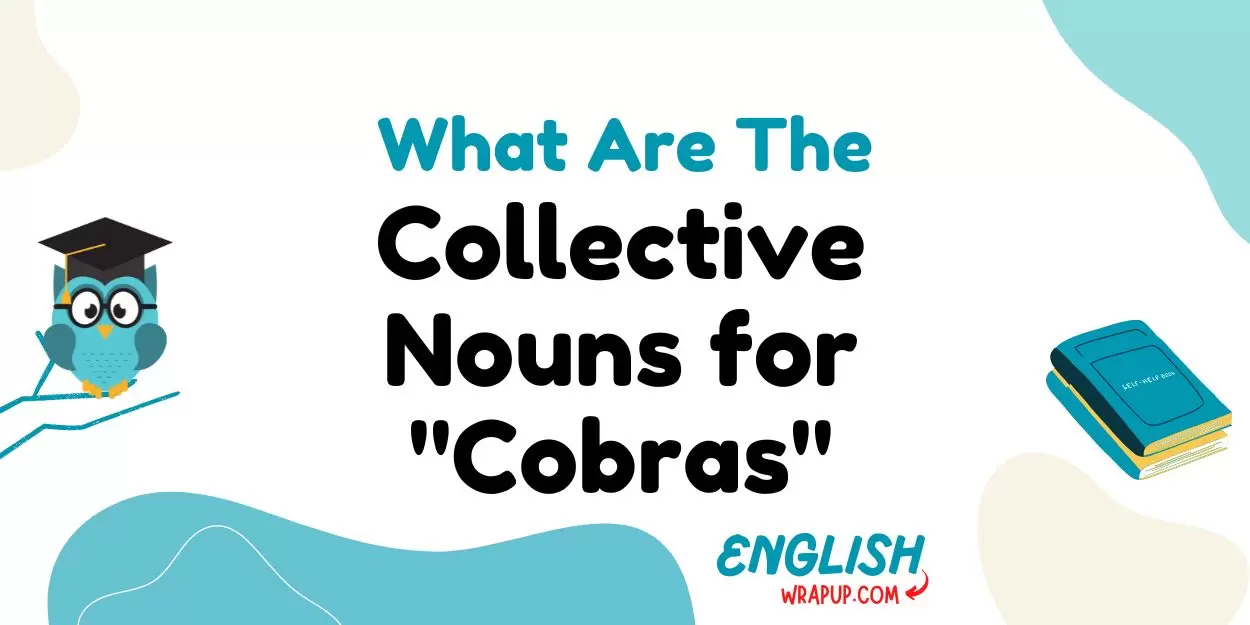Introduction
Cobras are fascinating creatures, known for their distinctive hood and venomous bite. These sleek reptiles often evoke a sense of both awe and fear. But have you ever wondered what you call a group of cobras?
Collective nouns provide us with unique and descriptive terms for groups of animals, objects, or people.
What Are Collective Nouns?
Collective nouns are singular words that refer to groups of people, animals, or things. They encapsulate the essence of the collective entity, offering colorful and imaginative descriptors for various assemblies.
From a “flock” of birds to a “herd” of cattle, collective nouns enrich the English language with vivid imagery.
Best Collective Nouns For Cobras
- Quiver
- Nest
- Den
- Coil
- Hood
- Slither
- Threat
- Charm
- Pit
- Fang
10 Collective Nouns for Cobras
1. Quiver
Explanation: A quiver typically denotes a container for arrows. However, when applied to cobras, it symbolizes their readiness to strike collectively. Example: A quiver of cobras slithered silently through the dense undergrowth, their hoods flaring as they sensed danger.

2. Nest
Explanation: While usually associated with birds, “nest” can also describe a group of cobras coiled together, perhaps during mating season or to conserve warmth. Example: In the corner of the abandoned temple, a nest of cobras basked in the afternoon sun, their scales shimmering in the golden light.
3. Den
Explanation: “Den” conjures images of shelter and security, suggesting a gathering of cobras seeking refuge or protection. Example: As the monsoon rains lashed the forest, a den of cobras huddled together beneath the roots of an ancient banyan tree, safe from the elements.
4. Coil
Explanation: Referring to the distinctive posture of cobras when they raise their upper body off the ground, “coil” captures their serpentine form and potential threat. Example: A menacing coil of cobras guarded the entrance to the sacred temple, their hisses warning intruders to stay away.
5. Hood
Explanation: The “hood” of cobras, when used collectively, highlights their characteristic defense mechanism and unified presence. Example: Emerging from the shadows, a hood of cobras surrounded the unsuspecting traveler, their mesmerizing gaze locking him in place.

6. Slither
Explanation: Evoking the sinuous movement of these reptiles, “slither” portrays a group of cobras on the move, perhaps in search of prey or a new territory. Example: Across the arid plains, a slither of cobras glided effortlessly, their sleek bodies weaving through the parched grass.
7. Threat
Explanation: “Threat” underscores the inherent danger associated with cobras, emphasizing their collective potential to intimidate or attack. Example: Caught off guard, the villagers recoiled as a threat of cobras emerged from the shadows, their warning hisses echoing through the night.
8. Charm
Explanation: Despite their lethal reputation, cobras possess a certain allure, making “charm” an apt descriptor for a group of these mesmerizing serpents.
Example: Tourists marveled at the charm of cobras swaying to the hypnotic music of the snake charmer, their movements synchronized in a mesmerizing dance.
9. Pit
Explanation: “Pit” conveys a sense of depth and containment, suggesting a congregation of cobras in a confined space, such as a burrow or rocky crevice. Example: Within the dark recesses of the ancient ruins, a hidden pit of cobras lay in wait, their collective gaze fixated on unsuspecting prey.
10. Fang
Explanation: Symbolizing the lethal weaponry of cobras, “fang” epitomizes their collective potential for swift and deadly action. Example: In the dim light of dusk, a fang of cobras coiled around their prey, their venomous bites delivering swift justice to the unwary intruder.
Other Ways to Say “Spirit Animal”
Interesting Facts About Cobras
- Cobras belong to the family Elapidae, which includes some of the most venomous snakes in the world.
- The Indian cobra, also known as the spectacled cobra, is one of the most iconic species, recognizable by the spectacle-shaped markings on its hood.
- Cobras are renowned for their ability to “hood up,” flattening their neck ribs and spreading the skin to create a distinctive hood when threatened.
Final Thoughts
Collective nouns not only provide linguistic richness but also offer insights into the behavior and characteristics of the entities they describe.
In the case of cobras, these collective terms evoke a sense of both fascination and trepidation, capturing the essence of these enigmatic serpents in vivid detail.
From the graceful “slither” to the menacing “threat,” each collective noun paints a unique portrait of these remarkable creatures, enriching our understanding of their collective behavior and societal dynamics.

I’m Ava Thompson, your expert guide at “English WRAP Up.” I’ve been immersed in the world of English language tests, helping students ace TOEFL, IELTS, BULATS, FCE, CAE, and PTEG. With a wealth of experience in teaching and grading, I’m here to help you master your English exams. Join me on this educational journey, and let’s wrap up your English skills with excellence!



